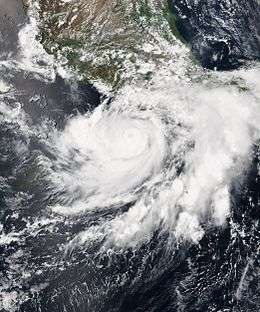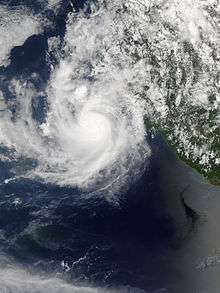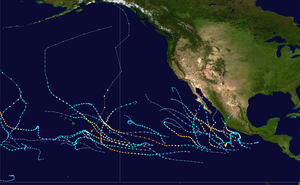Hurricane Carlos (2015)
Hurricane Carlos was an unusually small tropical cyclone which affected the western coast of Mexico in June 2015. Forming as the third named storm and hurricane of the annual hurricane season, Carlos developed from a trough first noted by the National Hurricane Center on June 7. The disturbance gradually organized and was designated as a tropical depression three days later while south of the Mexican Pacific coast. Drifting slowly northwestward, the depression was upgraded further to a tropical storm. Although persistent wind shear and dry air hampered intensification early on, Carlos strengthened into a hurricane on June 13 after moving into a more favorable environment. However, the return of dry air and upwelling of cooler waters caused the system to deteriorate into a tropical storm. Paralleling the Mexican coast, Carlos later regained hurricane intensity on June 15 and attained peak winds of 90 mph (150 km/h) a day later. The reprieve was brief, however, as the onset of wind shear, land interaction, and dry air afterward led to rapid weakening. On June 17, Carlos degenerated into a remnant area of low pressure, having made landfall in Jalisco earlier that day. By the morning of June 18, Carlos was declared to have completely dissipated.
| Category 1 hurricane (SSHWS/NWS) | |
 Hurricane Carlos near its initial peak intensity on June 13 | |
| Formed | June 10, 2015 |
|---|---|
| Dissipated | June 18, 2015 |
| (Remnant low after June 17) | |
| Highest winds | 1-minute sustained: 90 mph (150 km/h) |
| Lowest pressure | 978 mbar (hPa); 28.88 inHg |
| Fatalities | None |
| Damage | $1.04 million (2015 USD) |
| Areas affected | Southwestern and Western Mexico |
| Part of the 2015 Pacific hurricane season | |
Carlos's close track to Mexico prompted coastal authorities to enact precautionary measures along states deemed at risk, including the issuance of tropical cyclone warnings and watches over a large swath of the coast, extending from Acapulco to Cabo Corrientes. In Guerrero, more than 500 shelters were opened, and schools in most of the state were closed. Rough seas along the shore generated by the hurricane caused widespread damage, which included the sinking of 12 ships in Playa Manzanillo harbor. The waves combined with heavy rain to inflict at least MXN$5 million (US$326,000) of damage on Michoacán's coastal installations. Strong winds produced by the passing storm also downed trees, power poles, and billboards along much of the western Mexican coast. In Jalisco, classes were also suspended in anticipation of heavy rains, however, damage in the state was relatively minor. Overall, Carlos caused roughly MXN$16 million (US$1.04 million) worth of damage across Mexico.
Meteorological history

Late on June 2, the National Hurricane Center (NHC) highlighted the potential for an area of low pressure to form well south of the coasts of Guatemala and El Salvador over subsequent days.[1] This forecast came to fruition early on June 7, when shower and thunderstorm activity began to increase in association with a trough south of the Gulf of Tehuantepec.[2] Steered steadily northwestward by a subtropical ridge, the disturbance acquired organized, deep convection near the center, prompting the NHC to upgrade it to a tropical depression at 18:00 UTC on June 10.[3] Following the formation of a spiral band that wrapped more than half way around the center, the depression was upgraded to Tropical Storm Carlos at 12:00 UTC the following day while positioned about 230 miles (370 km) south of Acapulco, Mexico.[3]
Following its designation as a named storm, Carlos drifted generally north-northwestward while embedded within a weak steering regime.[4] The cyclone struggled with a combination of northerly wind shear and dry air entrainment, limiting the storm's associated deep convection to the eastern quadrant.[5] By early on June 13, however, a ragged eye became evident on visible satellite imagery as the upper-level environment became increasingly conducive for intensification, and Carlos was upgraded to a Category 1 hurricane on the Saffir–Simpson scale at 12:00 UTC.[3] Deep convection became increasingly symmetric about the eye, and the cyclone reached its initial peak intensity six hours later with winds of 85 mph (140 km/h) and a minimum pressure of 978 mbar (hPa; 28.88 inHg).[6] However, early on June 14, the presentation of Carlos began to deteriorate as a result of upwelling and the ingestion of dry air; the eye became obscured and banding features decreased as evident on satellite imagery, while the eyewall became increasingly ill-defined on radar.[7] At 00:00 UTC on June 15, the storm was downgraded to a tropical storm about 75 mi (120 km) west-southwest of Acapulco.[3]

Over the next 24 hours, Carlos changed little in structure as it tracked to the west-northwest under the influence of a mid-level ridge across central Mexico.[8] However, a microwave pass early on June 15 indicated the presence of a small, closed eye,[9] and an Air Force Reserve reconnaissance aircraft investigating the system a few hours later recorded peak 700 mb flight-level winds of 79 mph (127 km/h) and surface winds in the range of 74–77 mph (119–124 km/h).[10] As a result, Carlos was once again upgraded to a Category 1 hurricane.[11] Despite persistent northerly wind shear, the presentation continued to improve throughout the morning hours of June 16, with deep convection near the center and a banding eye feature observable.[12] Concurrent with this period of intensification, Carlos's radius of maximum wind decreased to around 6 mi (9 km), a feature noted as "very unusual" by the NHC.[3] A second reconnaissance mission into the storm around 18:00 UTC that day found that the storm had attained winds of 90 mph (150 km/h), despite the minimum pressure only reaching a low of 984 mbar (hPa; 29.06 inHg).[13] Over the next few hours, Carlos quickly weakened as the environment became unfavorable.[14] At 09:00 UTC on June 17, the storm made landfall near Tenacatita, Jalisco, with winds of 50 mph (85 km/h).[3] By that evening, Carlos had degraded into a depression,[15] and not long after Carlos was declared a remnant low.[16] The remaining vortex later moved back over water as it accelerated to the northwest, and dissipated near the Islas Marías before 06:00 UTC on June 18.[3]
Preparations and impact
Shortly after Carlos's designation, authorities in Guerrero suspended classes for five municipalities.[17] Statewide, 507 shelters were opened, including 98 in Acapulco.[18] The ports of Acapulco and Zihuatanejo were closed for navigation on June 13 and swimming in the ocean was banned in the former.[19][20] Simultaneously, a tropical storm watch was issued for Acapulco to Punta San Telmo.[3] After Carlos became a hurricane, officials activated a red alert in southwestern Guerrero, while a yellow alert was declared for Michoacan and the rest of Guerrero.[21] Seven other states were placed under lower levels of alert.[21] At 21:00 UTC on June 13, the tropical storm watch was upgraded to a warning, and a hurricane warning was issued from Tecpán de Galeana to Lázaro Cárdenas.[3] On June 15, despite Carlos weakening to a tropical storm, the remainder of Guerrero was placed on an orange alert.[22] On the afternoon of June 15, the hurricane warning was discontinued, but a hurricane watch remained in effect from Punta San Telmo to Playa Perula.[3] Later, as Carlos restrengthened to a hurricane, the orange alert was relocated to most of Colima, southern Michoacán and western Guerrero, while the yellow alert was moved to cover the rest of the three aforementioned states.[23] The tropical storm warning was extended to cover up to Cabo Corrientes, however, the warnings south of Manzanillo were discontinued at 18:00 UTC on June 17.[3] Classes in six municipalities of Jalisco were suspended by the authorities.[24] Eventually, the remaining warnings and watches, were discontinued as Carlos weakened and later dissipated.[3]
Strong winds downed several trees and power poles in coastal Guerrero.[25] High waves caused localized flooding in tourist areas, leaving three automobiles trapped in Acapulco.[21] Within the city itself, 17 trees and three billboards were toppled and some locations lost power.[20] A total of 16 homes were washed away.[26] One person was injured when a wall collapsed.[27] At the Playa Manzanillo harbor, 37 ships were damaged, of which 12 sunk.[28] The Bellissima, a luxury yacht reportedly worth MXN$11 million (US$717,000) owned by businessman and politician Jorge Kahwagi, was among the vessels sunk by the storm.[29] Large waves up to 4.5 m (15 ft) high and heavy rain caused at least MXN$5 million (US$326,000) in damage to coastal installations across Michoacán.[30][31] Farther north in Guadalajara, Jalisco, Carlos was thought to have caused one death when a person was fatally injured by falling metal.[27] However, the NHC later determined that the death was caused by severe weather unrelated to Carlos.[3]
See also
References
- Jack L. Beven II (June 2, 2015). "Tropical Weather Outlook valid 500pm PDT Tue Jun 2 2015" (TXT). Miami, Florida: National Hurricane Center. Retrieved June 10, 2015.
- Eric S. Blake (June 7, 2015). "Tropical Weather Outlook valid 500am PDT Sun Jun 7 2015" (TXT). Miami, Florida: National Hurricane Center. Retrieved June 10, 2015.
- John L. Beven II; Christopher W. Landsea (October 27, 2015). Hurricane Carlos (PDF) (Report). Tropical Cyclone Report. Miami, Florida: National Hurricane Center. Retrieved May 21, 2017.
- Richard J. Pasch; David A. Zelinsky (June 11, 2015). "Tropical Storm Carlos Discussion Number 5". Miami, Florida: National Hurricane Center. Retrieved June 16, 2015.
- Jack L. Beven II (June 12, 2015). "Tropical Storm Carlos Discussion Number 10". Miami, Florida: National Hurricane Center. Retrieved June 16, 2015.
- Eric S. Blake (June 13, 2015). "Hurricane Carlos Discussion Number 13". Miami, Florida: National Hurricane Center. Retrieved June 16, 2015.
- Eric S. Blake (June 14, 2015). "Hurricane Carlos Discussion Number 15". Miami, Florida: National Hurricane Center. Retrieved June 16, 2015.
- Dave P. Roberts (June 15, 2015). "Tropical Storm Carlos Discussion Number 19". Miami, Florida: National Hurricane Center. Retrieved June 16, 2015.
- Stacy R. Stewart (June 15, 2015). "Tropical Storm Carlos Discussion Number 20". Miami, Florida: National Hurricane Center. Retrieved June 16, 2015.
- Stacy R. Stewart (June 15, 2015). "Hurricane Carlos Discussion Number 21". Miami, Florida: National Hurricane Center. Retrieved June 16, 2015.
- Stacy R. Stewart (June 15, 2015). "Hurricane Carlos Intermediate Advisory Number 20A". Miami, Florida: National Hurricane Center. Retrieved June 15, 2015.
- Dave P. Roberts (June 16, 2015). "Hurricane Carlos Discussion Number 23". Miami, Florida: National Hurricane Center. Retrieved June 16, 2015.
- Robbie J. Berg (June 16, 2015). "Hurricane Carlos Discussion Number 25". Miami, Florida: National Hurricane Center. Retrieved June 17, 2015.
- Dave P. Roberts (June 17, 2015). "Tropical Storm Carlos Discussion Number 27". Miami, Florida: National Hurricane Center. Retrieved June 21, 2015.
- Stacy R. Stewart (June 17, 2015). "Tropical Depression Carlos Intermediate Advisory Number 28a". Miami, Florida: National Hurricane Center. Retrieved June 21, 2015.
- Stacy R. Stewart (June 17, 2015). "Post-Tropical Cyclone Carlos Discussion Number 29". Miami, Florida: National Hurricane Center. Retrieved June 21, 2015.
- "Suspenden clases 5 municipios de Guerrero por depresión tropical". El Universal (in Spanish). June 10, 2015. Retrieved June 14, 2015.
- "Tropical Storm Carlos hits at Acapulco with high winds, surf". NewsOK. June 14, 2014. Retrieved June 14, 2014.
- "Cierran Acapulco y Zihuatanejo a la navegación". El Universal (in Spanish). June 13, 2015. Retrieved June 14, 2015.
- "Carlos afecta servicio eléctrico en Acapulco". El Universal (in Spanish). June 14, 2015. Retrieved June 14, 2015.
- "Elevan a naranja la alerta por Carlos". El Universal (in Spanish). June 13, 2015. Retrieved June 14, 2015.
- "Se amplía alerta naranja en Guerrero por Carlos". El Universal (in Spanish). June 15, 2015. Retrieved June 15, 2015.
- "Mantienen alerta en 10 estados por huracán "Carlos"". El Universal (in Spanish). June 16, 2015. Retrieved May 21, 2017.
- "Suspenden clases en 6 municipios de Jalisco por Carlos". El Universal (in Spanish). June 16, 2015. Retrieved May 21, 2017.
- "Se Registran, Hasta El Momento, Daños Menores Por 'Carlos' En Guerrero" (in Spanish). Acapulco, Guerrero: Bajo Palabra. June 12, 2015. Retrieved June 12, 2015.
- "Tropical Storm Carlos hits at Acapulco with high winds, surf". Mercury News (in Spanish). Associated Press. June 14, 2015. Retrieved June 14, 2015.
- "Huracán Carlos deja un muerto y daños a su paso por México". El Universal (in Spanish). June 14, 2014. Retrieved June 14, 2015.
- Héctor Briseño (June 21, 2015). "Dueños de lanchas dañadas por 'Carlos' en Guerrero, sin recursos para repararlas" (in Spanish). Acapulco, Mexico: La Jordana. Retrieved June 22, 2015.
- "Tormenta causada por huracán Carlos hundió yate de Jorge Kahwagi en Acapulco". SPDnoticias.com (in Spanish). Mexico City. June 18, 2015. Retrieved May 21, 2017.
- "Enramaderos de Lázaro Cárdenas, señalan cuantiosas pérdidas económicas por Carlos" (in Spanish). Lázaro Cárdenas, Michoacán: MiMorelia. June 18, 2015. Archived from the original on June 22, 2015. Retrieved June 22, 2015.
- "Mantienen alerta en 10 estados por huracán "Carlos"". El Universal (in Spanish). June 16, 2015. Retrieved May 21, 2017.
External links
| Wikimedia Commons has media related to Hurricane Carlos (2015). |
- The National Hurricane Center's advisory archive of Hurricane Carlos
- The National Hurricane Center's Tropical Cyclone Report for Hurricane Carlos
